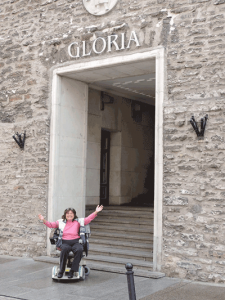While I had traveled extensively in the United States, I had never gone outside of our borders since becoming wheelchair dependent. But, in August my husband and I set out on our most ambitious trip ever. Three weeks in Europe! Our trip included time in Estonia, Denmark, Ireland and the UK. We knew that there would be different adjustments in different countries but tried to anticipate what we could and adjust to what we hadn’t.
The trip was amazing. We saw so many beautiful sights, met up with wonderful people and learned new things every day about ourselves and our world. Now that I have had a month to think about what we saw and experienced, I feel ready to summarize some memories as they relate to abilities, disabilities and travel.
Observation #1: ADA. Matters! Because of our 25+-year-old law, the US has more predictably consistent access for disabled travelers than we found in Europe. In all the cities and towns where we went there were some curb cuts, some ramps, some handicapped accessible bathrooms. But the certainty of finding them and the standards to which they were held did vary quite a bit. I heard that the EU has guidelines about handicapped access, but ultimately responsibility for setting and enforcing laws falls to the individual countries.
Observation # 2 Some European systems and products are better than ours and vice-versa. One of the greatest benefits of travel is the opportunity to see alternative ways to address “issues.” We found that American curb cuts and ramps are routinely smoother and safer. European handicapped accessible bathrooms are often easier and safer to use. It would be wonderful if we could learn more directly from each other. But for now, it is possible our best option is to keep finding ideas, sharing them with each other and pushing for implementing them where we live!
Observation # 3 People with disabilities seem more visible in the US. We were told that, for example, power wheelchairs and individuals moving about alone in them are rare in Europe. There may be many reasons for this (costs, insurance coverage, product availability, and more). But, I also believe that without the assurance of ADA-like mandates, disabled individuals can’t always count on being able to get around independently as we do in the US. Ultimately we found that we were able to go almost everywhere, but I had to rely much more heavily on my husband’s assistance than I do in the US. Even many advance phone calls and assurances from restaurants and other venues did not accurately prepare us for some of the obstacles we found.
Observation # 4 Even small towns, old cities and viewing sites for natural wonders can be made (mostly) handicapped accessible. It was great to see how much of an effort had been made to provide disabled travelers with a full and enjoyable experience. My powerchair traveled throughout the old cities of Tallinn and Copenhagen, along pathways at the Cliffs of Moher and Giants Causeway and around small towns like Doolin and Ballycastle.
Observation # 5 People are universally friendly and willing to help everywhere we travelled. Through the many situations where we didn’t know where we were going or what we were doing, smiling faces and helping hands welcomed us, guided us forward and encouraged us to enjoy the journey! And that we did!

And so, if you’re wondering “Can I do this?” My answer is a profound “Yes, you can!”
In the coming weeks I plan to blog more extensively about specific places we traveled and how I fared in going there with my powerchair . I also encourage you to read some of my reviews in TripAdvisor under the name of Your Accessible Life.

 This website is designed to give you practical tips, advice and links that will support your journey to seek out the solutions that work best for you.
This website is designed to give you practical tips, advice and links that will support your journey to seek out the solutions that work best for you.